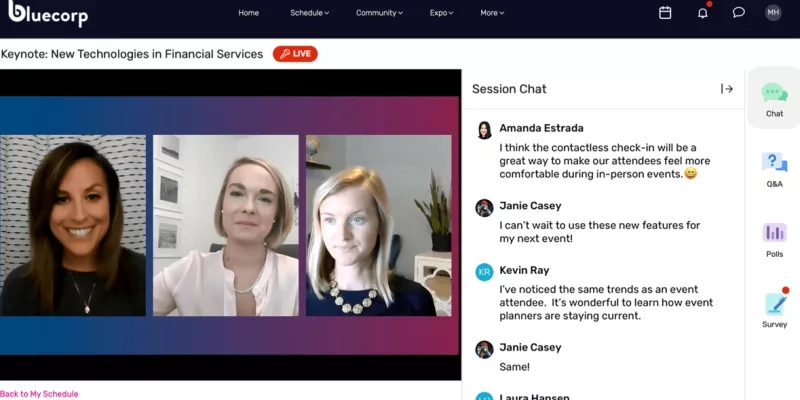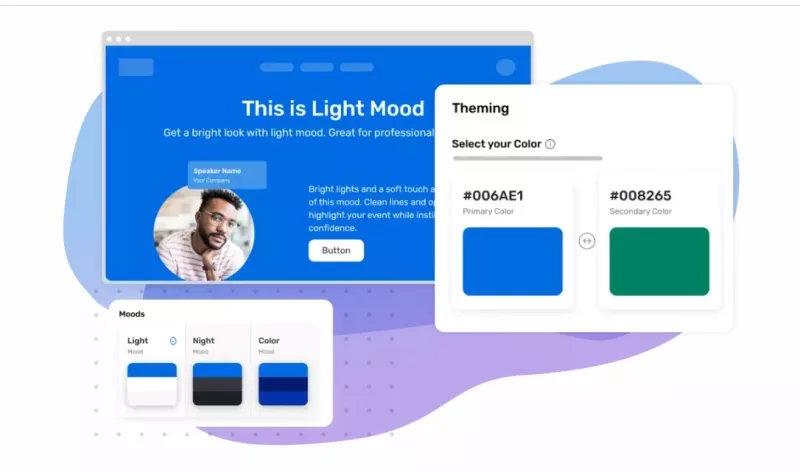In today's digital era, webinars have emerged as powerful tools for knowledge sharing, collaboration, and business growth. In fact, the webinar and webcast market size is projected to reach USD 4.79 Billion by 2030.
Whether you're a seasoned professional or a budding entrepreneur, understanding how to design and deliver engaging webinar formats is essential for making a meaningful impact on your audience. In this comprehensive guide, we delve into various webinar formats, exploring their nuances and offering insights into designing and delivering impactful virtual experiences.
Designing an Effective Webinar Format
In the dynamic landscape of virtual communication, designing an effective webinar format requires careful consideration of various elements to ensure an engaging and impactful session. From planning to execution, each of these webinar best practices play a pivotal role in delivering a seamless and valuable experience for participants.
Strategic Planning
Before diving into the webinar creation process, articulate clear objectives and define your target audience. What do you want participants to gain from the session? Understanding your goals will guide the content creation and format selection. Develop a detailed agenda, ensuring a balance between information delivery and interactive elements to keep attendees engaged.
Engagement Strategies
Keeping participants engaged is key to a successful webinar. Incorporate interactive elements such as polls, Q&A sessions, and live chats to encourage audience participation. Plan for breaks to avoid information overload and allow attendees to absorb key points. Additionally, consider guest speakers or panel discussions to add diversity and expertise to your webinar content.
Technology and Tools
Selecting the right technology is critical for a seamless webinar experience. Choose a reliable webinar software that aligns with your goals and audience size. Ensure compatibility with various devices and operating systems to maximize accessibility. Familiarize yourself with the platform's features, such as screen sharing, breakout rooms, and analytics, to enhance the overall webinar experience.
Visual Appeal
Design a visually appealing presentation to capture participants' attention. Use engaging visuals, such as slides, infographics, and videos, to convey information effectively. Maintain a clean and professional layout to avoid distractions. Leverage branding elements to create a cohesive and memorable experience for attendees.
Pre-webinar Promotion
Generate interest and boost attendance by promoting your webinar effectively. Utilize webinar templates for email marketing, social media, and other communication channels to reach your target audience. Clearly communicate the value proposition of your webinar, highlighting key takeaways and the expertise of speakers. Consider offering early bird incentives to encourage early webinar registration.
Technical Rehearsal
Conduct a thorough technical rehearsal before the actual webinar to iron out any potential glitches. Test audio and video quality, ensure smooth transitions between slides or segments, and verify interactive features. Address any technical issues promptly to maintain a polished and professional presentation.
Post-Webinar Engagement
Extend the webinar audience engagement beyond the meeting itself. Share post-event materials, such as recorded sessions, presentation slides, or additional resources, with participants. Encourage webinar feedback through surveys to gather insights for future improvements. Leverage social media to continue discussions and foster a sense of community among attendees.
10 Popular Webinar Formats
- Ask Me Anything (AMA) Session: In an AMA webinar, also known as a Q&A webinar, participants have the opportunity to pose questions directly to a host or expert, fostering open and unscripted dialogue.
- Expert Panel Discussion: An expert panel discussion involves bringing together a group of knowledgeable individuals to discuss a specific topic or industry.
- Debate-style Webinar: Structured as a debate, this format pits two or more speakers against each other, presenting opposing viewpoints on a specific topic.
- Interview Webinar: In an interview webinar, a host engages in a conversation with a guest, typically an expert or industry leader.
- Speaker Presentation: A speaker presentation is a traditional webinar format where a single presenter delivers content to the audience.
- Company/Product Showcase Webinar: In a company or product showcase webinar, the host highlights and demonstrates specific products, services, or the overall capabilities of a company.
- Interactive Demo/Webinar: An interactive demo webinar allows participants to explore software, tools, or products in real time.
- Hybrid Product Launch Webinar: Integrate online and offline elements for a product launch by combining a live event with a virtual audience.
- Lead Generation Webinar: A lead generation webinar is designed to capture and nurture potential leads through valuable content.
- Case Study Webinar: In a case study webinar, real-world examples and scenarios are presented to illustrate a particular concept, strategy, or solution.
Best Practices for Delivering an Engaging Webinar Format
Delivering engaging webinar presentations involves more than just sharing information—it requires careful planning, dynamic delivery, and thoughtful interaction to captivate your audience.
- Know Your Audience: Understanding your audience is the foundation of successful webinars. Tailor your content to their interests, level of expertise, and preferences.
- Craft a Compelling Introduction: Capture your audience's attention from the start with a compelling introduction. Clearly state the purpose of the webinar, highlight key takeaways, and establish a connection with participants.
- Interactive Elements: Incorporate interactive elements throughout the webinar to keep participants actively engaged. Polls, Q&A sessions, and live chats are effective tools to foster audience interaction.
- Dynamic Visuals: Utilize visually appealing slides, infographics, and videos to enhance your presentation. Visual elements not only break the monotony but also aid in conveying complex information more effectively.
- Engage with Your Voice: Your tone and delivery play a crucial role in keeping participants engaged. Speak clearly, vary your pitch, and infuse energy into your voice.
- Practice, Practice, Practice: Rehearse your webinar multiple times before the live session. Practice helps you refine your content delivery, ensures a smooth flow, and minimizes the chances of technical glitches.
- Effective Use of Time: Respect your participants' time by adhering to the scheduled timeframe. Keep the content concise and focused, allowing time for questions and discussions.
- Adapt to Virtual Challenges: Acknowledge and adapt to the challenges of a virtual environment. Be mindful of potential technical issues and have a backup plan in case of disruptions.
- Post-Webinar Follow-Up: Extend engagement beyond the webinar by providing post-event resources, such as presentation slides, additional materials, or links to related content.
- Continuous Improvement: Gather feedback after each webinar to understand what worked well and areas for improvement. Use analytics to track participant engagement and assess which elements resonated most with your audience.
How to Structure a Webinar
Hosting a webinar involves careful planning and execution to ensure a seamless and engaging experience for your audience. Follow these steps to structure a successful webinar that aligns with your goals and captivates your participants.
Step 1: Define Your Webinar Goals
Begin by clearly defining the webinar goals. Whether it's thought leadership, lead generation, or training, having a clear objective will guide the entire structure and content creation process.
Step 2: Choose the Right Webinar Format
Select the type of webinar format that best suits your goals. Consider whether an interview, expert panel discussion, or interactive workshop aligns with your content and audience preferences.
Step 3: Develop a Compelling Webinar Title
Craft a captivating title that not only reflects the webinar's content but also entices potential attendees. Use language that sparks interest and includes relevant keywords to optimize webinar registration.
Step 4: Create an Engaging Introduction
Open with a strong introduction to capture the audience's attention. Briefly introduce the topic and the webinar hosts, then outline what participants can expect. This sets the tone for an engaging session.
Step 5: Design Your Webinar Structure
Plan your webinar structure in a logical sequence. Use webinar format design principles to organize content effectively. This may include an agenda slide, key topics, and a clear progression to keep participants engaged.
Step 6: Incorporate Interactive Elements
Enhance participant engagement with interactive elements such as polls, Q&A sessions, and discussions. An interactive webinar format encourages active participation and creates a dynamic learning environment.
Step 7: Utilize Webinar Templates
Leverage pre-designed webinar templates to streamline your content creation. Templates provide a consistent visual identity and help organize information cohesively, making it easier for participants to follow.
Step 8: Offer Thought Leadership Insights
Infuse your webinar with thought leadership by sharing valuable insights, industry trends, and expert opinions. Establish yourself or your speakers as authoritative figures in the field.
Step 9: Implement Training Elements
If your webinar serves an educational purpose, incorporate training elements. Break down complex concepts into digestible segments, use visuals effectively, and encourage participant interaction to facilitate a training webinar environment.
Step 10: Guide Participants to a Call-to-Action
Toward the end of your webinar, seamlessly guide participants toward a clear call-to-action. This could be downloading additional resources, signing up for future webinars, or participating in a webinar lead generation activity.
Step 11: Promote Post-Webinar Engagement
Extend the conversation beyond the live session. Encourage participants to share their thoughts on social media, provide post-webinar resources, and gather feedback for continuous improvement.
By following this guide, you can structure a webinar that not only meets your objectives but also leaves a lasting impact on your audience. Remember to continuously analyze and refine your approach based on participant feedback and evolving industry trends.
Elevating Your Virtual Presence
In the ever-evolving landscape of virtual communication, mastering the art of webinar formats is no longer a luxury, but a necessity. From the traditional to the innovative, each format brings its own set of opportunities to connect, educate, and inspire.
By incorporating the diverse webinar formats discussed in this guide and adhering to best practices, you’ll have the tools to create impactful virtual experiences. Whether you're aiming to showcase products, share insights, generate leads, or foster community discussions, the right format and approach can elevate your virtual presence to new heights.











